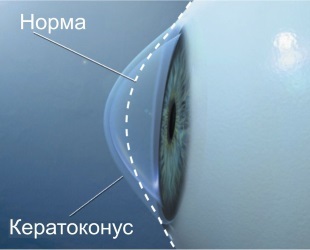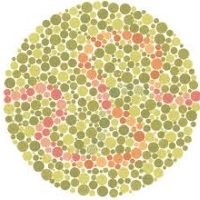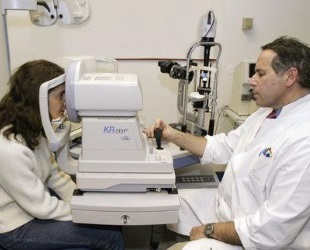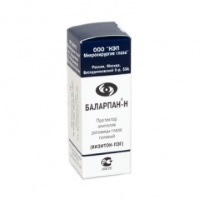
About common eye diseases, such as myopia, hyperopia, glaucoma, conjunctivitis, is known to everyone.
But among the diseases of the organ of vision there are also rare pathologies, which, unfortunately, can occur in every person.
And most of them can do a lot of harm and cause a lot of trouble that will negatively affect your eyesight.
One of these includes keratoconus - degenerative changes in the cornea, leading to its thinning and to a change in shape.
- 1. What is keratoconus
- 2. Causes of
- 3. Symptoms of
- 4. Stages of
- 5. Treatment and diagnosis of
- 6. Prognosis of
- 7. Prevention of
- 8. Conclusion of
What is keratoconus
In case of pathological diseasechanges occur in the tissues of the cornea, under their influence it is thinned, ceases to hold a normal spherical shape and extends forward in the form of a cone.
The first signs of the disease are recorded in adolescents under 16 years, in rare cases the disease first appears after 25 years. There is no dependence on race or sex, among older patients ophthalmology pathology is almost not detected.
Deformation of the cornea in keratoconus is associated with a variety of biochemical changes. The disease is characterized by a decrease in the production of collagen and total protein, enzyme deficiency is fixed, antioxidant activity decreases. Under the influence of all these changes, the cornea loses elasticity, easily undergoes stretching, and as a result, it assumes a conical shape.
Disease is dangerous due to decreased vision and development of astigmatism. And although retinal dystrophy never leads to a complete loss of vision, but can so worsen it, that a person will have to give up his usual activities.
Causes of
A certain role among the causes of the disease is assigned to hereditary enzymopathy, which begins to progress under the influence of hormonal changes occurring during adolescence. The disease is often detected in members of the same family, identical twins.
Disease often occurs in diseases such as:
- Down Syndrome.
- Bronchial asthma.
- Hay fever.
- Eczema.
- Addison's disease.
- Keratoconjunctivitis.

Read more - the test for color perception. Do you know about the coloranal?
In the news( link) treatment at home Iridocyclitis.
Reviews of hypromellosis!http: //moezrenie.com/lechenie/ kapli-dlya-glaz / gipromelloza-protektor-epiteliya-rogovitsy.html
Ultraviolet irradiation, dusty air, radiation doses contribute to the thinning of the cornea. Progression of the disease is facilitated by microtrauma, mechanical eye rubbing.
Symptoms of

Due to the fact that in the early stages of keratoconus is similar in symptoms to other eye diseases, the diagnosis is rarely exhibited immediately. To suspect a disease the doctor can already when using corrective glasses and lenses it is impossible to achieve a clear vision.
The disease is characterized by a number of certain signs, so a careful collection of anamnesis in the patient is an indispensable condition for examination.
The patient at the beginning of the pathological process complains about:
- Blurred image - when viewed from the subject, it appears to be a multi-circuit. To test this sign is not difficult - the patient is given a black sheet of paper with a white dot on it. When keratoconus, a person sees instead of a single point somewhat chaotically located.
- Doubling objects, distorting the shape of letters when reading.
- Light diffusion around light sources.
- In the later stages, photophobia, permanent eye fatigue, is attached.
Signs of vision impairment are first determined on one eye, then fixed on the other. In the early stages, all signs of pathology are fixed only in the twilight and night hours, then the patient begins to see badly in the afternoon. In later stages, the elongated, conical shape of the cornea is noticeable both to the surrounding and to the patient himself.
In most patients, the disease progresses slowly - changes are observed for 10 years or more. In half of patients, dystrophic changes are stopped at an early stage, and the disease passes to the stage of a long-term remission.
Sometimes the progression of dystrophic changes and stretching of the cornea leads to its complete thinning and rupture. Complication is characterized by edema of the cornea and a sharp pain syndrome. The acute stage can last up to three weeks, then the scars form on the cornea, and the vision improves in part.
Stages of
It is accepted to classify the disease into several stages, ophthalmologists often use the classification according to Amsler.
- The detected astigmatism is amenable to correction by means of cylindrical lenses. The visual acuity is 1,0-0,5 .
- Astigmatism is more pronounced, but also amenable to correction. Vision within the 0,4 - 0,1 .
- Cornea is thinner and noticeably stretched. Vision within 0.12-0.02 , correction is possible only with the use of hard lenses.
- The cornea assumes a conical shape, the vision is 0.02-0.01 , practically not amenable to correction. Full clouding of the cornea is revealed.
Treatment and Diagnosis

If suspected, in addition to collecting an anamnesis, a specific diagnosis is performed:
- Refractometry.
- Skiascopy reveals a "scissors effect" characteristic of keratoconus - a ray of light is perceived by the patient as the movement of two scissor blades.
- Topography of the cornea is considered one of the most accurate methods of diagnosis.
Keratoconus must be differentiated with other ophthalmic diseases that have a similar symptomatology. After all the examinations the doctor makes a decision about conservative or surgical treatment.
Correction of the revealed changes is carried out by wearing semi-rigid lenses designed in such a way that their central part has a rigid base, and the edges are made of soft material. Such lenses allow the cornea to be pressed into, giving it a normal position.
Additional treatment is the appointment of vitamin therapy, antioxidants, immunomodulators, eye drops. Effective use of magnetotherapy, phonophoresis with tocopherol.
When the disease progresses, corneal ring implantation is used to stabilize the cornea. Surgery for the disease also includes keratoplasty - transplantation of the donor's cornea. Almost all patients can achieve a 100% return of vision.
Cost of operation
Keratoplasty using the donor cornea is performed in exceptional cases. The leading centers of vision protection also carry out other equally effective surgical interventions.
- PRK + FTC - excimer laser procedure is carried out at the initial stages. Its carrying out allows you to suspend dystrophic changes, reduces the likelihood of developing indications for end-to-end keratoplasty. PRK + FTC improves vision and reduces astigmatism. The cost is about 30000 rubles for one eye.
- Crosslinking is an operation aimed at increasing the strength of the cornea. Manipulation is to remove the superficial epithelium of the cornea, followed by instillation of riboflavin and irradiation with UV rays. After it, the patient can wear ordinary glasses or soft lenses. The cost of the procedure is from 30000 rubles .
- Keraring - implantation of semirings, allowing to straighten the cone-shaped extension of the cornea. After cirrhring, visual function is improved, astigmatism is reduced, lens selection is facilitated. The cost of the operation within is 35 thousand rubles without the cost of semi-rings.

Notice - eye drops Balarpan. Detailed description of the medicinal product.
In the article( link) eye drops Arutimol.
Instructions for Oxolin Ointment!http: //moezrenie.com/lechenie/ glaznye-mazi / ispolzovanie-oksolinovoj-mazi.html
Where it's best to do the operation
Eye-related operations need to be done only in well-tried clinics that have been treating keratoconus for several years. Before choosing a technique the doctor should fully explain the pros and cons, in some cases, surgical intervention is not appropriate.
In Moscow, the illness is treated in the Center for Eye Surgery, in the clinics "New Look", "Excimer".Before the operation it is desirable to communicate with real patients, this will help evaluate the quality of medical care.
Treatment at home
Treatment with home remedies of keratoconus is ineffective. The patient can only minimize dystrophic changes using the wearing of prescription medications prescribed by the doctor. An ophthalmologist can recommend the use of biostimulants, immunomodulating medications.
Patients with keratoconus should refrain from combing their eyes, this further contributes to the thinning of the cornea.
What kind of drops are prescribed?
In this disease, as a rule, eye drops are assigned to Taufon. These drops interfere with the development of the disease in question and improve the nutrition of the eyes. Drops stimulate energy as well as recovery processes, make up for the natural deficiency of taurine, and also normalize the functions of the cellular membranes of the eye tissues.
In addition, with this disease can be appointed Aisotin. These drops have a complex of natural origin. Aisotin is a restorative, as well as a restorative, used to restore visual acuity.
You should take 1-2 drops 3 times a day, for the same prevention, you must instill 1 drop each time before going to bed. Contraindications, overdose, as well as side effects of the drug are absent.
Forecast
The forecast, as a rule, is favorable. With the advent of new treatments, this disease is no longer a serious problem. As a result of timely diagnosis, the current methods of treatment are able to completely cure a person of the disease. Modern equipment will find even the smallest change in the cornea.
Prevention
Carrying out general restorative actions not only helps stop the progression of the disease, but also prevents its appearance. It is best to replace the lens, designed to improve the eyesight, conventional glasses. This step will allow several times to reduce the damage occurring in the eye.
To relieve itching, burning or increased fatigue, the eyes should be washed and made compresses from such herbs as chamomile and sage. In addition, these herbs should be taken orally in the form of tea. Such prophylaxis will have an immunocorrective effect on the human body. For these purposes, you can also use a decoction prepared from leaves of echinacea.
Warning! Use only the herb on which you do not have an allergic reaction.
Conclusion
Keratoconus is a disease that, with timely treatment, has a favorable outcome. In no case should not engage in self-treatment, tk.with uncontrolled administration of medicines, the patient's condition may worsen.
That's why, in no case should you delay with a trip to the ophthalmologist with the first visual impairment.
